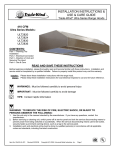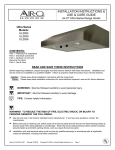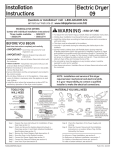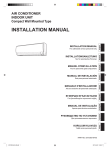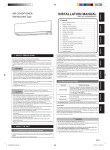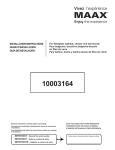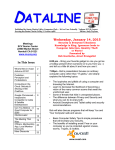Download American Standard 7236L Use & care guide
Transcript
INSTALLATION INSTRUCTIONS & USE & CARE GUIDE Trade-Wind® BBQ 7200 Series Range Hood 7200 Series Models: No Blower 7236 7242 7248 7254 7260 7266 1250 CFM 7236-12 7242-12 7248-12 7254-12 7260-12 7266-12 2300 CFM N/A N/A N/A 7254-23 7260-23 7266-23 CONTENTS: Part 1 - Planning The Installation Part 2 - Electrical Connection Part 3 - Direction of Vent and Securing The Hood Part 4 - Use & Care Before beginning installation, please thoroughly read and become familiar with these instructions. Installation and service must be completed by a qualified installer. Failure to properly install this product may void the warranty. ® Please be advised that the Trade-Wind 7200 Series Range Hood MAY NOT be installed on a Patio or Lanai area that does not have a roof over the Range Hood to protect it from direct rain or potential water ingress. This Hood should be installed with a MINIMUM of three (3) feet of weather proof roof coverage on all sides that are not protected from direct rain by an adjacent wall. It is required that all duct work and roof openings be thoroughly sealed with the applicable tape and/or roof sealant to prevent ingress of water. Installer: Owner: Please leave Installation Instructions with the range hood liner. Please keep Installation Instructions for local electrical inspector’s use and for future reference. WARNINGS: Must be followed carefully to avoid personal injury. IMPORTANT: Must be followed carefully to avoid damage or incorrect installation. TIPS: Contain helpful information to facilitate installation. READ AND SAVE THESE INSTRUCTIONS WARNING! TO REDUCE THE RISK OF FIRE, ELECTRICAL SHOCK, OR INJURY TO PERSONS OBSERVE THE FOLLOWING: a) Use this unit only in the manner intended by the manufacturer. If you have any questions, please contact the manufacturer at the address or telephone number listed in the warranty. b) Before servicing or cleaning unit, switch power off at service panel and lock service panel and lock the service disconnection means to prevent power from being switch on accidentally. When the service disconnecting means cannot be locked, securely fasten a prominent warning device, such as a tag to the service panel. Item No. 0BH-00-002 Revised 04/4/14 Copyright (C) 2008, Universal Metal Industries, Inc. Page 1 CAUTION -- For general ventilating use only. Do not use to exhaust hazardous or explosive materials and vapors. WARNING – TO REDUCE THE RISK OF A RANGE TOP GREASE FIRE: a) Never leave surface units unattended at high settings. Boilovers cause smoking and greasy spillovers that may ignite. Heat oils slowly on low or medium settings. b) Always turn hood ON when cooking at high heat or when flambeing food (i.e. Crepes Suzette, Cherries Jubilee, Peppercorn Beef Flambe’). c) Clean ventilating fans frequently. Grease should not be allowed to accumulate on fan or filter. d) Use proper pan size. Always use cookware appropriate for the size of the surface element. WARNING! TO REDUCE THE RISK OF INJURY TO PERSONS IN THE EVENT OF A RANGE TOP GREASE FIRE, OBSERVE THE FOLLOWING: a) SMOTHER FLAMES with a close-fitting lid, cookie sheet, or metal tray, then turn off the burner. BE CAREFUL TO PREVENT BURNS. If the flames do not go out immediately, EVACUATE AND CALL THE FIRE DEPARTMENT. b) NEVER PICK UP A FLAMING PAN—YOU MAY BE BURNED. c) DO NOT USE WATER, including wet dishclothes or towels - a violent steam explosion will result. d) Use an extinguisher ONLY if: 1. 2. 3. 4. You know you have a Class ABC extinguisher and you already know how to operate it. The fire is small and contained in the area where it started. The fire department is being called. You can fight the fire with your back to an exit. e) Follow the barbeque grill manufacturer’s instruction when using gas grills, cookers, or any propane appliances. f) BE CAREFUL TO PREVENT BURNS. If the flames do not go out immediately, EVACUATE AND CALL THE FIRE DEPARTMENT. Recommendations: 1. Consult a licensed ventilation contractor or qualified technician for proper installation of exhaust ducting. Locate the cooking area for minimum cross drafts-away from doors and windows, when possible. 2. Ducts must be of adequate size and duct runs should be as short as possible. Where turns are necessary, keep turning radius as large and as smooth as possible. 3. The ducting must be air tight. Use a minimum of 2 sheet metal screws at every duct joint. Then, seal the duct joints with high quality duct tape. 4. Do not use this unit with any solid-state speed control device. 5. This unit must be grounded. Item No. 0BH-00-002 Revised 04/4/14 Copyright (C) 2008, Universal Metal Industries, Inc. Page 2 INSTALLATION INSTRUCTIONS WARNING – TO REDUCE THE RISK OF FIRE, ELECTRIC SHOCK, OR INJURY TO PERSONS, OBSERVE THE FOLLOWING: a) Installation work and electrical wiring must be done by qualified person(s) in accordance with all applicable codes and standards, including fire-rated construction codes and standards. b) Sufficient air is needed for proper combustion and exhausting of gasses through the flue (chimney) of fuel burning equipment to prevent back drafting. Follow the heating equipment manufacturer's guidelines and safety standards such as those published by the National Fire Protection Association (NFPA) and the American Society for Heating, Refrigeration and Air Conditioning Engineers (ASHRAE) and the local code authorities. c) When cutting or drilling into wall or ceiling, do not damage electrical wiring and other hidden utilities. d) Ducted fans must always be vented to the outdoors. e) Some TRADE-WIND® 7200 Series Range Hoods are for wall mounting only. For safe and secure wall mounting, the TRADE-WIND® Hood should be mounted to a solid vertical surface of sufficient width to allow for mounting of the Hood. The horizontal surface should extend from a vertical plane to the point directly in front of the exhaust roof cap (or wall cap). f) The Hood should be installed with a MINIMUM of three (3) feet of weather proof roof coverage on all sides that are not protected from direct rain by an adjacent wall. g) It is also required that all duct work and roof openings be thoroughly sealed with the applicable tape and/or roof sealant to prevent ingress of water. WARNING -- TO REDUCE THE RISK OF FIRE, USE ONLY METAL DUCTWORK. CAUTION –To reduce the risk of fire and to properly exhaust air, be sure to duct air outside – Do not vent exhaust air into spaces with in walls or ceilings or into attics, crawl spaces, or garages. PART 1 Planning the Installation CAUTION: 1. For general ventilating use only. Do not use to exhaust hazardous or explosive materials and vapors. 2. To reduce the risk of fire and to properly exhaust air, the hood must be exhausted to outside air. Never exhaust into a wall, an attic or a concealed area in the building. This can create a potential hazard. 3. Consult a licensed ventilation contractor or qualified technician for proper installation of exhaust ducting. 4. Locate the cooking area for minimum cross drafts—away from doors and windows, when possible. 5. Ducts must be of adequate size and duct runs should be as short as possible. Where turns are necessary, keep turning radius as large and as smooth as possible. 6. The ducting must be air tight. Use a minimum of 2 sheet metal screws at every duct joint. Then, seal the duct joints with high quality duct tape. 7. Only use ductwork constructed of materials deemed acceptable by state, municipal and local codes. 8. Plan the installation so that all minimum clearances are met or exceeded. Dimensions shown provide minimum clearances, unless otherwise specified. Item No. 0BH-00-002 Revised 04/4/14 Copyright (C) 2008, Universal Metal Industries, Inc. Page 3 IMPORTANT: All dimensions are nominal +/- 1/8”. FRONT VIEW Model # (No Blower) (1250 CFM) 7236 7242 7248 7254 7260 7266 7236-12 7242-12 7248-12 7254-12 7260-12 7266-12 **INSTALLER MUST DUCT TAPE PERFORATED KNOCKOUT AREA TO ENSURE SEALED SMOKE CAPTURE AREA. TOP/REAR VIEW 36”, 42”, 48”, 54”, 60”, 66” Item No. 0BH-00-002 Revised 04/4/14 Copyright (C) 2008, Universal Metal Industries, Inc. Page 4 IMPORTANT: All dimensions are nominal +/- 1/8”. FRONT VIEW Model # (No Blower) (2300 CFM) 7254 7260 7266 7254-23 7260-23 7266-23 **INSTALLER MUST DUCT TAPE PERFORATED KNOCKOUT AREA TO ENSURE SEALED SMOKE CAPTURE AREA. TOP/REAR VIEW Item No. 0BH-00-002 Revised 04/4/14 Copyright (C) 2008, Universal Metal Industries, Inc. Page 5 WARNING! Following are Manufacturer’s Suggestions. Always Observe Local Building Codes. Hoods installed in custom canopies constructed of combustible materials should be installed with the combustible material structure a minimum of 36” above the cooking surface. Hoods installed in custom canopies constructed of non-combustible materials, should be installed with the non-combustible material structure a minimum of 30” above the cooking surface. Follow all instructions regarding minimum safe clearances and installation location. Failure to do so may result in a safety hazard or fire. To reduce the risk of fire use only metal ductwork. PART 2 Electrical Connection WARNING! Ensure that the power supply is disconnected before proceeding. Verify that the power supply matches the ratings found on the appliance data label before proceeding. The complete appliance must be properly grounded at all times when electrical power is applied. Do not ground the appliance with the neutral (white) house supply wire. A separate ground wire must be utilized. Failure to complete electrical connections properly may result in damaged or non-functional systems. Follow instructions carefully to ensure proper installation. It is the owner’s responsibility to ensure that a qualified person performs the electrical connection of this appliance. The electrical installation, including minimum supply wire size, must comply with the National Electric Code ANSI/NFPA 70-1990 (or latest revision) and local codes and ordinances. A copy of this standard may be obtained from: National Fire Protection Association, 1 Batterymarch Park, Quincy, Massachusetts 02169-7471 Important Electrical Requirements: Observe all National and local governing codes and ordinances. Have all electrical installation done by a qualified electrical installer. This Hood requires a 120 Volt, 60 Hertz electrical supply of an individual properly grounded branch circuit protected by a 15 or 20 Amp circuit breaker. The TRADE-WIND® 7200 Series Range Hood is supplied with a 6.0 Amp three speed fan control. For safety precautions, each Ventilation Hood should be installed in a GFCI protected branch circuit. INSTRUCTIONS: Wire connections: (See Diagram Below) There are 3 wires on the front panel that require connection. BLACK WHITE GREEN 120 VAC from electrical panel (usually black) Neutral from electrical panel (white) Ground from electrical panel (usually green) CAUTION: The neutral wire (white) must only be connected to the white neutral wire coming in from the electrical panel. House Electrical Panel Green White (N) 120V Black (L) Hood Item No. 0BH-00-002 Revised 04/4/14 BLK WHT GRN Copyright (C) 2008, Universal Metal Industries, Inc. Page 6 PART 3 Determining Direction of Vent and Securing the Hood MOUNTING HOLES: Because the TRADE-WIND® 7200 Series Range Hood was designed for all applications, no mounting holes have been pre-drilled. This allows for custom applications for mounting. The hood should be attached to the framing through the top and back, whenever possible. Remove the filters. Mark and drill screw holes through the hood as required. Secure the hood by driving screws (provided by others) through the screw holes. **NOTE: DRILLING THROUGH STAINLESS STEEL REQUIRES TITANIUM DRILL BITS. BE CAREFUL NOT TO DRILL THROUGH THE UL LABEL OR INTO THE HOOD’S ELECTRICAL COMPONENTS PART 4 Use and Care OPERATING CONTROLS: Always activate the ventilator when using cooking appliances. Activate the ventilator a few minutes before starting to cook to establish an airflow pattern within the room. Adjust the fan speed as needed. Adjust the dimmable halogen lights as desired. WARNING! Do NOT operate the blower / ventilator system without the filters in place, or with dirty, grease laden filters. ENERGY SAVING TIPS: Do not operate the blower at a speed higher than necessary to remove the cooking exhaust. Turn off the unit once the smoke and cooking odors have been eliminated. Clean filters and grease laden surfaces often to improve efficiency. CARE & CLEANING: Proper cleaning is necessary to maintain performance and appearance, while also ensuring safe operation. The frequency of cleaning should be adjusted according to the type and amount of cooking. Best results will be achieved by cleaning soiled components as soon as possible. Filters must be cleaned regularly. The commercialstyle baffle filters should have the long slots running front to back. The filters may be cleaned by hand washing in hot water using a mild detergent solution, or by placing them in a dishwasher. Dry the filters completely before using again. Stainless steel surfaces should be cleaned with a solution of mild detergent and warm water. Rinse and dry with a soft lint-free cloth. CAUTION: If a commercially available stainless steel cleaner is used, it is important to read the labels for chlorine compounds. Chlorine is a corrosive substance. If these compounds are present, rinse thoroughly and dry with a soft lint-free cloth. Follow polish manufacturer’s instructions. Always wipe stainless steel surfaces with the grain. Never wipe across the grain. After cleaning, reinstall the filters carefully. Most common scrubber type pads will scratch the hood. HALOGEN LIGHT BULBS: Hoods are designed for PAR 20 halogen lamps. They can be purchased at most home and/or grocery stores, e.g., McCoys, Lowe’s, Fry’s, Kroger, Albertsons, True Value, Home Depot, etc. We endeavor to incorporate the best technology provided to our industry, in manufacturing the TRADE-WIND® products, therefore, we reserve the right to change models, mode of operation, and specification without prior notice. Item No. 0BH-00-002 Revised 04/4/14 Copyright (C) 2008, Universal Metal Industries, Inc. Page 7 WARRANTY Trade-Wind® 7200 Series Range Hood Ventilation Products What is Covered ® Universal Metal Industries, Inc., warrants its TRADE-WIND 7200 Series Range Hood ventilation products to the original user, to be free of defects in materials and workmanship for one (1) year from the date of purchase. Universal Metal Industries, Inc., at its option, will repair or replace the complete unit or any defective component without charge. This warranty may be voided if any unauthorized service, alterations or repairs are made to the product. What is Not Covered Normal maintenance and service of any product that has been subject to misuse, negligence, accident or installation inconsistent with the recommended installation instructions. Product used other than for normal in-home use or products used outside of the United States. Damage to the product caused by accident, fire, flood or other acts of God. Service calls to educate the customer in the proper use and care of the product, correct faulty installation, change fuses or reset breakers. Universal Metal Industries, Inc. disclaims and excludes any liability for implied warranties or for incidental or consequential damages wherever permitted by law. There are no implied warranties of merchantability or fitness for a particular use or purpose. This warranty gives you specific legal rights and you may also have other rights, which vary from state to state. For Service If you need service, contact Customer Service at the address or phone number below. Provide the model number, part identification and details of the problem. Proof of purchase must be provided. Warranty Revised 02/25/04 Universal Metal Industries, Inc. has a policy of continuous improvements and reserves the right to modify (at any time and without notice) any or all of its products, features, designs, components and specifications. Some features may be slightly different than shown on product literature. ® For more information, please contact your Trade-Wind Representative 800 West Grant Street, Phoenix, AZ 85007 800 875-3654 Phone 800 809-0995 Fax 602 251-3654 Phone 602 251-3889 Fax umiphx.com customrangehoods.com trade-windonline.com Item No. 0BH-00-002 Revised 04/4/14 Copyright (C) 2008, Universal Metal Industries, Inc. Page 8 Best Practices Venting Installation Instructions Addendum to Installation Instructions Model: 7200 Series IMPORTANT: Problems caused by improper installations are not covered by the manufacturer’s warranty. IMPORTANT: Undersized and improperly installed duct pipe and/or other ventilation components will cause excessive static pressure (air resistance), that may result in rattling, vibration and air buffeting noises, as well as inadequate ventilation. 1. Building Codes Kitchen Hood Ventilators should be installed by qualified technicians familiar with state and local building codes. 2. 3. Duct Pipe and Fittings (Elbows, Transitions, Roof & Wall Caps) a. Use round or rectangular rigid metal duct only. Where possible, use round duct as it creates the least amount of static pressure. DO NOT use flex duct. b. All duct sections and fittings (EXCEPT DAMPERS, per Section 4), should overlap and be connected with at least 3 – 4 equally spaced screws and wrapped tightly with 2 – 3 layers of Aluminum Foil Metal Duct Tape. This type of duct tape is more durable than traditional cloth duct tape. DO NOT use butt joints. c. For best air flow, elbows and pipe size transition fittings should not be directly connected to one another. Where possible, always include at least 15 inches of straight pipe between fittings. Duct Pipe and Fitting Sizes IMPORTANT: No portion of any length of duct pipe or fitting should be smaller than the discharge port of the ventilator. This is very important because any type of restriction anywhere in the ventilation system will cause increased static pressure (air resistance), that may result in rattling, vibration and air buffeting noises, as well as inadequate ventilation. See Duct Sizing Chart and Area Calculations section for more detail. Duct Runs – Length a. Configure the ventilation duct run to be as short and as direct to the outside as possible. Minimize the number of elbows and transition fittings used. Complex or long runs should be reviewed by a qualified installer. 4. b. No portion of the ducting should be run so that the exhaust air flows downward. Since exhaust heat rises, forcing the air to flow downward will cause increased static pressure. As previously mentioned, improperly installed duct pipe will cause excessive static pressure (air resistance), that may result in rattling, vibration and air buffeting noises, as well as inadequate ventilation. c. Duct runs for 1250 CFM ventilator models should not exceed 35 linear feet with two 90-degree elbows and two 45-degree elbows, a damper and a roof or wall cap. Longer runs or additional elbows will result in decreased ventilation performance. Each 90-degree elbow is the equivalent of 6 linear feet of duct pipe; each 45-degree elbow is equivalent to 3 linear feet of duct pipe. d. Always run ventilator ducts to the outdoors. DO NOT terminate a duct into an attic, basement, garage, crawl space under a house, a chimney, other ducting or an enclosed room. Dampers IMPORTANT: DO NOT USE SCREWS TO ATTACH ANY TYPE OF DAMPER AS THE SCREWS MAY BLOCK THE DAMPER BLADES. IMPORTANT: DO NOT USE MORE THAN ONE DAMPER IN THE VENTILATION SYSTEM. NOTE: Many styles of roof caps and wall caps have built-in dampers. See Roof Caps and Wall Caps section for more detail. Always use carefully crafted, tightly wrapped Aluminum Foil Metal Duct Tape on all connections and physically view and test the damper blades to make certain they are opening and closing correctly. Make sure that the damper blades do not touch the duct walls and that there is no debris blocking the free movement of the damper mechanism. Common things to look for include screws protruding into the blade’s path, overspray of paint, plaster and insulation. If using rectangular duct, be sure that all four sides of the duct are on the outside of the damper’s start collar or frame. Item No. 0BH-00-002 Revised 04/4/14 Copyright (C) 2008, Universal Metal Industries, Inc. Page 9 Damper in Roof Cap or Wall Cap In ventilation systems utilizing a roof cap or wall cap with a built-in damper, do not install an additional in-line damper. Two dampers are unnecessary and will cause increased static pressure (air resistance), that may result in rattling, vibration and air buffeting noises, as well as inadequate ventilation. In-line Damper (for ventilation systems utilizing a roof cap or wall cap without a built-in damper) In cold weather areas, installing an “in-line” damper may be the preferred type of installation. This is because in-line dampers installed just above the perimeter of the heated space (the ceiling) will reduce the amount of cold air traveling down the duct into the heated space and into the kitchen through the ventilator. In-line dampers must be installed so that the exhaust air flow will open the butterfly blades. For horizontal duct runs, the damper must be installed so that the hinge between the two butterfly blades is vertical—the hinge pin must point up and down. Otherwise, because of gravity, the damper’s blades will not close and the damper will not prevent backdrafts. For vertical duct runs, the in-line damper’s hinge will be horizontal (sideways), which is correct for vertical duct runs. Gravity will help close the damper blades after each use. For upward slanted duct runs, the in-line damper’s hinge must point to the top and bottom sides of the duct. In his position, gravity will help close the damper blades after each use. Otherwise, because of gravity, the damper’s blades will not close and the damper will not prevent backdrafts. 5. Roof Caps and Wall Caps The roof cap or wall cap is the termination point of the venting system that allows the exhaust air to exit to the outdoors. All sections of this fitting must have an equal or greater air path area than the ventilator’s discharge port. If any section of the roof cap or wall cap is smaller than the ventilator’s discharge port, the entire ventilation system will lose efficiency and the restriction will cause increased static pressure and decrease performance. IMPORTANT: Even though the intake side of the roof cap or wall cap may be properly sized, roof caps or wall caps with built-in dampers must be made so that when the damper is fully open, the actual open area of the final air path is equal to or greater than the discharge port of the ventilator. Any undersized portion of a roof cap or wall cap will cause excessive static pressure that may result in rattling, vibration and air buffeting noises, as well as inadequate ventilation. Do Not use “goose-neck style” caps as they significantly restrict natural, heated air-flow. Do Not use caps with dampers for BBQ Hoods. Fig. 1 Fig. 2 The air exit opening on the roof cap used needs to be at or above 78.5 square inches. See illustrations above. Never use a roof cap like the one shown in Figure 1. Instead use a style similar to the one shown in Figure 2. 6. Attaching Duct to House Framework The ventilation system should be attached to the framework in such a manner that the weight of the duct and fittings is supported with no stress on the duct joints, fittings or on the ventilator. All ducting should be attached so as to avoid any possible duct vibration from being transferred to the house’s framework. 7. Hoods with Optional Top or Back Venting IMPORTANT: On all models, the open holes/slots around the unused venting port MUST BE SEALED with Aluminum Foil Metal Duct Tape. Otherwise, exhaust air and smoke will be vented through the unused Vent Knockout’s holes/slots. UNUSED PORTS SHOULD BE TAPED BEFORE THE RANGE HOOD IS MOUNTED TO THE WALL OR CABINET. Item No. 0BH-00-002 Revised 04/4/14 Copyright (C) 2008, Universal Metal Industries, Inc. Page 10 8. Duct Sizing Chart and Area Calculations Minimum Discharge Size of Roofcap or Wallcap Outside Opening 10” Round Metal Duct or Minimum Duct Size (in Square Inches) 78.5” 8” x 10” Rectangular Duct 80” 80” Ventilator Discharge Port Types & Sizes Duct Type Required 10” Diameter, Round (Area is 78.5 Square Inches) 78.5” Formulas for Calculating Square Inches of Various Duct Sizes & Types Radius x Radius ROUND DUCT x 3.1416 = Area (Sq. Inches) Width x RECTANGULAR DUCT Depth = Area (Sq. Inches) The “radius” is one-half the diameter of a round duct, e.g., ½ of a 10” round duct is 5”. 3.1416 is “Pi”, the “constant” used when calculating the area of a circle. 9. Best Smoke Capture Recommendations Smoke and hot air from an Outdoor BBQ Grill rises quickly, especially as the BBQ lid is opened. Not only does the smoke rise fast, but it is usually deflected forward (toward the cook) beyond the range hood’s capture area by the shape and position of the BBQ lid itself. Heavy, fast rising smoke is a challenge even for high-performance range hoods, but there are some things you can do to enhance your outdoor range hood’s performance. B A a. Install the hood at least 30”, but no more than 36” above the cooking surface. If the hood is installed more than 36” above the cooking surface, its’ smoke capture ability declines rapidly. See Drawing A. b. Since smoke also expands as it rises, the hood’s sides and front edge should extend 3” – 6” beyond the front and sides of the cooking surface—see Drawing B. In this example, the hood is attached to a built-out section of the wall or to a chase. It is unlikely that smoke rising past the bottom of the range hood will be captured by the hood. Smoke escaping the hood’s capture area will typically remain against the ceiling until it is blown out by natural air currents or until it dissipates. c. Turn the hood on high 2 -3 minutes prior to placing food on the grill. If there is no wind or wind drafts, an upward flowing air “curtain” will be created by the hood’s suction that moves air up the sides and front of the cooking surface. This upward moving air curtain will help capture much of the smoke. d. Wind and wind drafts will also negatively affect the capture ability of high-performance outdoor range hoods. If the BBQ grill is located in a consistently windy area, e.g., near oceans, large lakes or on hillside properties, for best range hood performance, a wind-break may be required. Item No. 0BH-00-002 Revised 04/4/14 Copyright (C) 2008, Universal Metal Industries, Inc. Page 11











